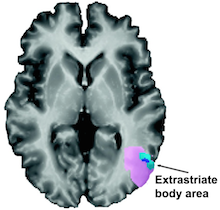Listening to metaphors involving arms or legs loops in a region of the brain responsible for visual perception of those body parts, scientists have discovered.
The finding, recently published in Brain & Language, is another example of how neuroscience studies are providing evidence for “grounded cognition” – the idea that comprehension of abstract concepts in the brain is built upon concrete experiences, a proposal whose history extends back millennia to Aristotle.

The EBA was shown in 2001 to respond selectively to images of the human body by Nancy Kanwisher and colleagues.
When study participants heard sentences that included phrases such as “shoulder responsibility,” “foot the bill” or “twist my arm”, they tended to engage a region of the brain called the left extrastriate body area or EBA.
The same level of activation was not seen when participants heard literal sentences containing phrases with a similar meaning, such as “take responsibility” or “pay the bill.” The study included 12 right-handed, English-speaking people, and blood flow in their brains was monitored by functional MRI (magnetic resonance imaging).
“The EBA is part of the extrastriate visual cortex, and it was known to be involved in identifying body parts,” says senior author Krish Sathian, MD, PhD, professor of neurology, rehabilitation medicine, and psychology at Emory University. “We found that the metaphor selectivity of the EBA matches its visual selectivity.” Read more




